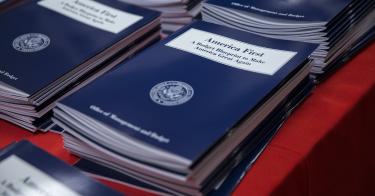President Donald Trump released the first budget blueprint of his new administration Thursday. The self-titled “America First Budget” outlines the president’s priorities for discretionary spending.
Recent news reports indicate the Trump administration relied heavily on The Heritage Foundation’s “Blueprint for Balance” to craft some of the ideas included in Trump’s own budget blueprint.
Following Thursday’s release, Heritage experts were quick to review the president’s proposals for downsizing the federal government and rightsizing the federal bureaucracy. Here is their analysis.
Government Debt and Spending
Romina Boccia declared that the budget, “marks a stark contrast from the reckless spending of the past Administration.”
The new budget proposal put a high priority on national defense. While the FY18 defense boost would be fully paid for with cuts to nondefense programs, the proposal would raise the FY17 Budget Control Act caps by $10 billion. Boccia suggests that the president “should set a precedent this year that budgeting is about prioritizing which means fully offsetting any new spending.”
All-in-all she says, “the proposed cuts to non-defense programs, together with executive actions to streamline federal agencies and cut waste, signal that this administration is serious about cutting the bloated Washington bureaucracy down to size. Congress should work with the administration to bring greater accountability to government and to eliminate federal programs that intervene in areas that are rightfully the domain of the private sector or state and local government.”
Defense and Military Readiness
On the defense side of the equation, retired-General Tom Spoehr says that the “Trump administration’s defense budget request of $603 billion for 2018 represents both reason for optimism and recognition of some stark budgetary realities,” adding, “President Trump's proposal to increase defense spending by around $18 billion above previously planned budgets is helpful and represents a clear commitment to rebuilding the military, and it is encouraging that the administration is willing to take on the fight to repeal caps on defense spending implemented by the Budget Control Act.”
However, this increase proposed by the administration is “insufficient to begin the much-needed re-building – rather, it represents an ‘on ramp’ to the process. An $18-billion increase will not be enough to regrow the military, rebuild near-term readiness, and commence needed modernization programs. Heritage recommends a 2018 defense budget of $632 billion, with the additional implementation of $14 billion in savings we have proposed through various initiatives.”
State Department to Refocus on Statecraft
Brett Schaefer and James Carafano weigh in on the budget cuts to the State Department, saying, “the cuts to the State Department budget proposed by the Trump administration largely represent a return to focusing taxpayer dollars on the business of true statecraft and away from funding global pet projects championed by the Obama administration."
Furthermore, they add “the State Department budget grew roughly 30 percent under President Obama, yet the jump in spending has failed to make the world safer for the United States or our allies. North Korea continues to threaten Japan and South Korea, Iran – further emboldened by a misguided nuclear deal – is destabilizing the Middle East, and Russia continues to exert itself over eastern Europe largely unchecked. The administration is right to refocus on supporting statecraft that will advance American interests and benefit our allies.” and James Carafano weigh in on the budget cuts to the State Department, saying, “the cuts to the State Department budget proposed by the Trump administration largely represent a return to focusing taxpayer dollars on the business of true statecraft and away from funding global pet projects championed by the Obama administration."
Department of Education
“For the first time in decades, the Trump administration is significantly trimming the budget at the U.S. Department of Education, demonstrating a commitment to restoring federalism in education,” according to Lindsey Burke, Director of the Center for Education Policy at Heritage.
Burkes argues, “the budget correctly zeroes out funding for various programs, such as the 21st Century Community Learning Centers Program and the Supporting Effective Instruction state grants program.” According to her, “ it is not appropriate for the federal government to fund high school counseling programs, after-school programs, teacher professional development and a myriad other programs it currently runs.”
Burke does make one caveat though saying “while the budget makes great strides in reducing federal spending on ineffective education programs, it also suggests spending $250 billion on new ‘private school choice program.’ This is well-intentioned but not the best role for the federal government, as it could entangle Washington in local school policy and private education.”
For more reaction to Trump’s skinny budget, see these commentaries from our experts:




